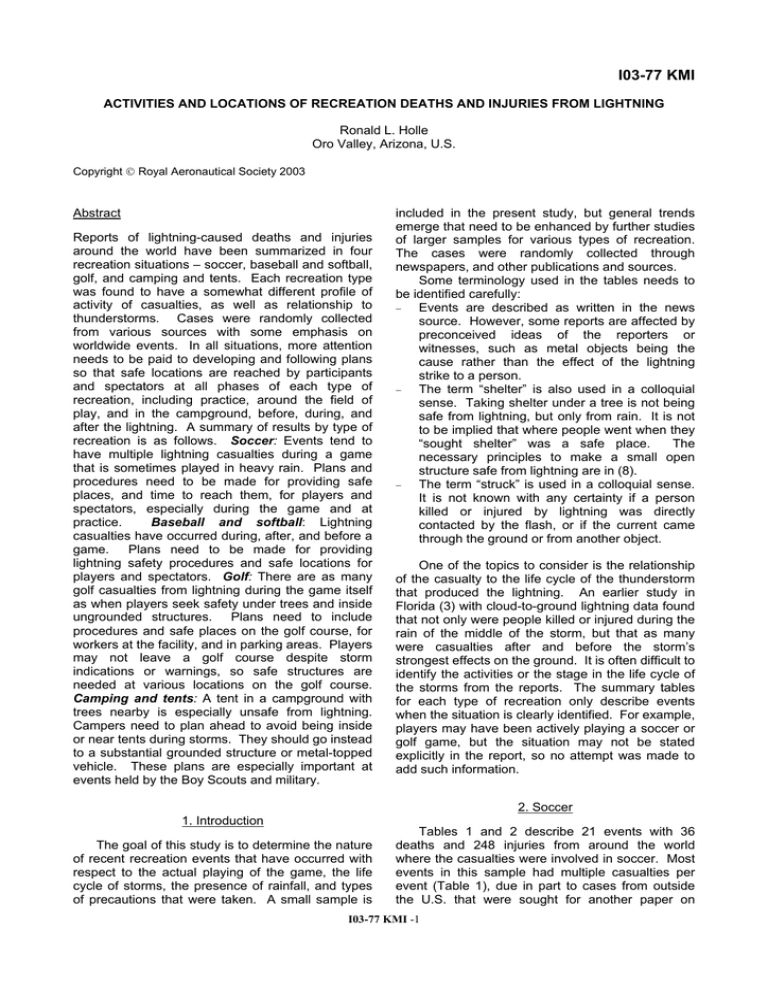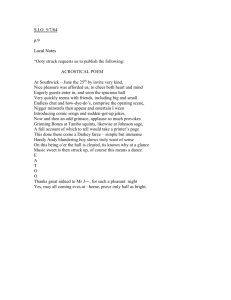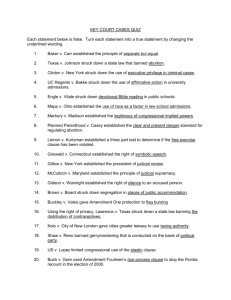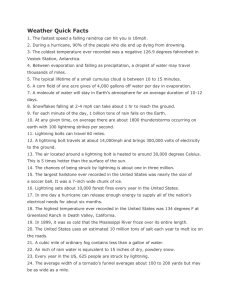I03-77 KMI - Lightning Strike and Electric Shock Survivors
advertisement

I03-77 KMI ACTIVITIES AND LOCATIONS OF RECREATION DEATHS AND INJURIES FROM LIGHTNING Ronald L. Holle Oro Valley, Arizona, U.S. Copyright Royal Aeronautical Society 2003 Abstract Reports of lightning-caused deaths and injuries around the world have been summarized in four recreation situations – soccer, baseball and softball, golf, and camping and tents. Each recreation type was found to have a somewhat different profile of activity of casualties, as well as relationship to thunderstorms. Cases were randomly collected from various sources with some emphasis on worldwide events. In all situations, more attention needs to be paid to developing and following plans so that safe locations are reached by participants and spectators at all phases of each type of recreation, including practice, around the field of play, and in the campground, before, during, and after the lightning. A summary of results by type of recreation is as follows. Soccer: Events tend to have multiple lightning casualties during a game that is sometimes played in heavy rain. Plans and procedures need to be made for providing safe places, and time to reach them, for players and spectators, especially during the game and at practice. Baseball and softball: Lightning casualties have occurred during, after, and before a game. Plans need to be made for providing lightning safety procedures and safe locations for players and spectators. Golf: There are as many golf casualties from lightning during the game itself as when players seek safety under trees and inside ungrounded structures. Plans need to include procedures and safe places on the golf course, for workers at the facility, and in parking areas. Players may not leave a golf course despite storm indications or warnings, so safe structures are needed at various locations on the golf course. Camping and tents: A tent in a campground with trees nearby is especially unsafe from lightning. Campers need to plan ahead to avoid being inside or near tents during storms. They should go instead to a substantial grounded structure or metal-topped vehicle. These plans are especially important at events held by the Boy Scouts and military. included in the present study, but general trends emerge that need to be enhanced by further studies of larger samples for various types of recreation. The cases were randomly collected through newspapers, and other publications and sources. Some terminology used in the tables needs to be identified carefully: − Events are described as written in the news source. However, some reports are affected by preconceived ideas of the reporters or witnesses, such as metal objects being the cause rather than the effect of the lightning strike to a person. − The term “shelter” is also used in a colloquial sense. Taking shelter under a tree is not being safe from lightning, but only from rain. It is not to be implied that where people went when they “sought shelter” was a safe place. The necessary principles to make a small open structure safe from lightning are in (8). − The term “struck” is used in a colloquial sense. It is not known with any certainty if a person killed or injured by lightning was directly contacted by the flash, or if the current came through the ground or from another object. One of the topics to consider is the relationship of the casualty to the life cycle of the thunderstorm that produced the lightning. An earlier study in Florida (3) with cloud-to-ground lightning data found that not only were people killed or injured during the rain of the middle of the storm, but that as many were casualties after and before the storm’s strongest effects on the ground. It is often difficult to identify the activities or the stage in the life cycle of the storms from the reports. The summary tables for each type of recreation only describe events when the situation is clearly identified. For example, players may have been actively playing a soccer or golf game, but the situation may not be stated explicitly in the report, so no attempt was made to add such information. 2. Soccer 1. Introduction The goal of this study is to determine the nature of recent recreation events that have occurred with respect to the actual playing of the game, the life cycle of storms, the presence of rainfall, and types of precautions that were taken. A small sample is Tables 1 and 2 describe 21 events with 36 deaths and 248 injuries from around the world where the casualties were involved in soccer. Most events in this sample had multiple casualties per event (Table 1), due in part to cases from outside the U.S. that were sought for another paper on I03-77 KMI -1 worldwide lightning casualties in this conference volume (6). In more than half of the events, the lightning strike occurred during the playing of a soccer game (Table 1). Five of the events occurred during heavy rain -- soccer matches tend to be continued despite adverse weather conditions, whether there is lightning present or not. Two others were during practice, and several occurred when fans sought safety under trees or an ungrounded structure. In summary, soccer events tend to have multiple lightning casualties during a game that is sometimes being played in heavy rain. Results indicate that the safety issue involves more than the players during the game itself. Plans and procedures need to be made for providing safe places for players and spectators, and time to reach them. Regardless of the rain intensity, much more attention needs to be paid to lightning as a threat at soccer matches and practices. TABLE 1. Major activities of people killed and injured during 21 soccer events. Activity Events Multiple casualties per event 13 During game 10 During heavy rain/storm 5 After game was stopped 3 Under tree 3 During practice/training 2 Taking shelter from storm 2 Kicking soccer ball in back yard 1 3. Baseball and softball Tables 3 and 4 describe 18 cases with 9 deaths and 95 injuries that were collected where the casualties were involved in baseball and softball. About a third of this sample of events occurred during the playing of a baseball or softball game. Four events took place after a game was canceled or suspended. Two others occurred before a game began. In summary, baseball and softball events may have lightning casualties during, after, or before a game. The results indicate that the safety issue involves more than taking care of the players during the game itself. Plans also need to be made for providing lightning safety procedures before and after the game for players and spectators. TABLE 3. Major activities of people killed and injured during 18 baseball and softball events. Activity Events During game 6 After game suspended or canceled 4 Prior to game 2 In dugout during thunderstorm 1 TABLE 2. Cases of lightning deaths and injuries during 21 soccer events. Deaths – injuries Location Description of soccer event 0–6 0 – 11 2–3 0–1 2 – 10 Australia Canada Colombia Germany Guatemala 17 - 35 Honduras 4 – 21 1 – 15 0–1 5 – 100 1–5 0–6 0 – 22 1–0 0–4 1–0 Indonesia Japan Japan Malawi South Africa South Africa South Africa U.S./Florida U.S./Florida U.S./Illinois 0–1 U.S./Kansas Flash struck field during a club soccer game in April 2001 Soccer players sought shelter under 4 trees during heavy rain in June 2001 Training in a stadium while it was raining very hard in October 2002 Playing soccer in July 2002 Flash hit metal guard rail around field during fierce rains after officials elected to continue the game in August 2001 Flash struck crowd standing under a shelter next to soccer field during heavy rain in June 1995 While playing soccer in September 1993 On soccer field during play in May 1979 (7) On soccer field during play in August 1996 (7) At a soccer game in November 2001 Playing soccer with friends during tournament in December 2002 Flash hit playing field during a game in October 1998 Flash struck field during game in October 1998 Struck while crossing a soccer field in June 1986 (3) Flash struck tree near soccer field in July 1993 Flash struck metal goal post being moved by goalie after game called by weather in July 1993 Girl struck during high school game on a soaked field in March 1998. The flash produced the first thunder heard all day I03-77 KMI -2 0–1 U.S./Oklahoma 0–3 1–0 1–3 U.S./Penn. U.S./Texas Yugoslavia Youth soccer coach closing car windows struck by lightning 4 minutes after game was stopped in August Flash struck just after game canceled due to threatening storm in June 1994 Man kicking soccer ball under tree in yard just before heavy rain in August 2001 During practice in a stadium during a heavy storm in May 2000 TABLE 4. Cases of lightning deaths and injuries during 18 baseball and softball events. Deaths – injuries Location Description of baseball and softball events 1 – 23 0–1 1–1 1–3 1–0 1 – 13 0 – 11 0–0 Canada Canada Japan Japan Japan Japan U.S./Florida U.S./Florida 0–2 U.S./Illinois 0–1 0–2 U.S./Mississippi U.S./N. Carolina 1–0 U.S./Ohio 1–1 0–4 0 – 20 0–6 U.S./Penn. U.S./S. Carolina U.S./Tennessee U.S./Tennessee 0–2 2–5 U.S./Virginia U.S./Wisconsin Flash struck baseball field after game was delayed in August 1994 Struck at baseball tournament in July 2001 Flash struck baseball field during play in July 1977 (7) Flash struck baseball field during play in July 1978 (7) Flash struck baseball field during play in August 1982 (7) Flash struck baseball field during play in July 1984 (7) Coach and 10 players struck at ball field in May 1995 Several major league players “shaken” when flash hit upper deck of stadium 3 hours before game in June 2000 Two baseball coaches struck when they checked on the field after rain had passed and sky had brightened slightly; players were in cars during storm in June 2002 Flash struck softball field in July 2001 Player and one spectator struck during baseball game as dark cloud and light rain began from storm moving up to 40 mi per hour/64 km per hour in June 2001 Man struck while herding children to shelter just after softball game was canceled due to approaching severe storm in April 2001 Struck while playing softball on field in July 1992 Flash struck tree near car after tournament canceled by umpires in July 1993 Flash struck softball field in May 1992 Flash struck player in dugout of baseball field seeking protection from thunderstorm in July 2001 Flash struck player and spectator at baseball game in July 2001 Flash struck baseball field during warmup in July 1945 4. Golf Tables 5 and 6 describe 38 cases with 23 deaths and 56 injuries that were collected where the casualties were involved in golf. Less than half of these golf events occurred while people were playing a golf game. About a third also occurred when golfers sought safety under a tree or other unsafe structure on the course. Several others were casualties while working at golf facilities. Two were in the parking lot after stopping play. In summary, golf events tend to have equally as many casualties during a game as when players seek safety under trees and beneath ungrounded structures. Golf safety involves a wider range of people than only the players on the course itself. Plans need to provide procedures and safe places on the golf course, for workers at the facility, and in the parking areas. Players often do not leave the course despite storm indications or warnings. Installation of safe structures at several locations on the course may be the best way to avoid lightning. TABLE 5. Major activities of people killed and injured during 38 golf events. Activity Events Playing golf 15 Taking shelter from storm 14 Working at golf course or driving range 3 In parking lot 2 Running to shelter 1 5. Camping and tents Tables 7 and 8 describe 29 cases with 11 deaths and 125 injuries that were collected where the casualties were involved in camping and/or tents. In nearly half of the cases, lightning first struck a nearby tree or pole. Nearly as many people were inside their tents when the event occurred. About a third of the cases involved Boy Scout or Civil Air Patrol campgrounds, where lightning casualties were typically teenagers. In summary, being in a tent in a campground with trees nearby is especially unsafe from lightning. For camping and tent safety from lightning, campers need to plan ahead and avoid being inside or near tents during storms, but go instead to a substantial grounded structure or metal-topped vehicle. Plans are especially important at group camping events such as those held by the Boy Scouts and military. I03-77 KMI -3 TABLE 7. Major activities of people killed and injured during 29 camping and tent events. Activity Events Flash struck tree and/or pole 12 Inside tent 11 At Boy Scout or Civil Air Patrol campground 7 Sitting outside tent 2 Under tarp or damaged tent in storm 2 Dismantling tent due to tornado warning 1 Running to shelter 1 TABLE 6. Cases of lightning deaths and injuries during 38 golf events. Deaths – injuries Location Description of golf event 1–0 0–1 1–1 0–2 1–4 0–1 Australia Australia Canada Canada Japan U.K. 1–0 1–1 0–4 1–0 0–2 0–3 1–1 1–0 0–3 0–1 1–0 2–0 1–1 0–1 0–1 1–5 1–1 1–3 2–1 0–1 0–2 U.S./Colorado U.S./Colorado U.S./Colorado U.S./Florida U.S./Florida U.S./Florida U.S./Georgia U.S./Hawaii U.S./Illinois U.S./Illinois U.S./Indiana U.S./Kentucky U.S./Louisiana U.S./Mass. U.S./Mass. U.S./Minnesota U.S./Nevada U.S./N. Carolina U.S./Ohio U.S./Ohio U.S./Ohio 0–4 U.S./Oklahoma 1–0 1–2 0–4 2–0 1–1 0–2 0–1 0–1 0–1 1–0 U.S./Penn. U.S./Penn. U.S./S. Carolina U.S./S. Carolina U.S./S. Carolina U.S./Texas U.S./Texas U.S./Texas U.S./Virginia U.S./Virginia Struck during golf game in June 1999 Struck during golf game in June 1999 Sought shelter under a tree during golf game during a storm in June 1994 Struck during golf game in July 2001 Flash struck a tree on a golf course in July 1987 (7) Sought shelter under umbrella when heavy rain began during golf game in June 2002 Struck while playing golf in August 1992 Sought shelter under a tree during golf game during a storm in July 1997 Struck while continuing to play golf after seeing distant flashes in July 2001 Struck while looking for golf balls in June 1990 (3) Struck while hitting practice balls at driving range in July 1997 th Struck while running to clubhouse after stopping play at 16 hole in July 1997 Under umbrella under tree during golf game during storm in August 1998 Playing golf Under umbrella during storm delay during golf tournament in 1975 Struck tree during rain but no prior lightning during golf game in August 1989 In parking lot at golf tournament after day’s play was cancelled by storm in 1991 Sought shelter under tree when it started to rain during golf game in Sept. 1992 Sought shelter under a tree during golf game during a storm in July 2000 Struck while putting on golf course in May 2000 Struck while raking yard at golf course in April 2002 Sought shelter under a tree during a storm delay in golf tournament in June 1991 At golf course in May 1993 Sought shelter in a shed next to a tree on a golf course during storm in July 1995 Struck playing golf in September 1998 Struck while working at driving range in June 2000 Struck while continuing to play golf while sun was shining after seeing distant flashes in July 2000 Sought shelter during golf game under trees 15 minutes after warning siren sounded in June 1994 In parking lot of golf course in July 1993 Sought shelter under tree during golf game on golf course in June 1995 Sought shelter in a shed on a golf course rest stop during a storm in July 1993 Struck on golf course in June 1994 Sought shelter in wooded area during golf game on golf course in August 1998 Struck by first flash of storm during golf game in August 1990 Struck while continuing to play golf after storm warning issued in July 2001 Struck while continuing to play golf after seeing flashes miles away in August 2001 Struck while working on golf course in May 2000 Struck under tree during golf game on golf course although friends took shelter in May 2000 6. Discussion The use of the 30-30 rule has been recommended to apply to recreation events involving groups of people outside (4). The first 30 applies to a 30 second flash-to-bang time for going to a safe place at the start of a storm; this time relates to a distance of 6 mi/9.7 km. The second 30 refers to waiting 30 minutes after the last lightning. The tradeoffs involved in the choice of these distances and times are described in detail in (5). In the U.S., the 30-30 recommendation was endorsed by the National Collegiate Athletic Association (NCAA). This example has led other local and recreational sports leagues to adopt the rule. During the NCAA college women’s softball tournament in Oklahoma City in 2000, a game was suspended when lightning was detected within 6 mi/9.6 km of the stadium. Application of this rule I03-77 KMI -4 has also resulted in several nationally-televised football contests being postponed or canceled in the last few years. Following such rules would reduce but not eliminate the cases shown in Tables 1 to 8. TABLE 8. Cases of lightning deaths and injuries during 29 camping and tent events. Deaths – injuries Location 0–1 0–2 0–5 4 – 19 1–0 1–0 0–6 0–1 0–1 0–1 0–1 1–0 0–5 0–1 0–1 1–0 0–7 0–4 0–3 0–1 1–3 0–9 0 – 26 1–2 1–5 0 – 13 0–3 0–1 0–4 Description of camping event France France Nearby tree struck at campsite where woman was leaning against car in 2001 (2) Nearby tree struck at campsite where woman sitting in chair in front of tent in 2001 (2) Japan Struck tree and tent pole while inside tent in August 1978 (7) South Africa Large tent’s steel pole struck during night when schoolgirls and 2 adults were sleeping in November 1994 (1) U.S./Arizona Lightning struck tent while victim was inside in May 1997 U.S./Arizona Migrant worker killed inside tent near a tree in desert in May 1997 U.S./Colorado Struck while seeking shelter under a tarp when thunderstorm began at Boy Scout campground in July 1997 U.S./Colorado Struck while camping at high altitude when storm approached in July 1998 U.S./Colorado Struck tree near tent at Boy Scout campground in July 2001 U.S./Colorado Struck tree 10 ft/3 m away at campground in August 2001 U.S./Colorado Struck above tree line before rain began at campground in August 2001 U.S./Florida Struck boy riding bicycle in campground in June 1988 (3) U.S./Florida Struck tree sent bark flying while walking during sudden thunderstorm at church summer camp in June 2001 U.S./Maryland Struck taking shelter under damaged tent at memorial site during high winds in June 2001 U.S. Mississippi Nearby tree struck while inside tent in May 2001 U.S. Mississippi Nearby tree struck and current traveled to victim running from a tent to a truck at a campsite in May 2001 U.S./Missouri Six struck in and near tent, and one on pay phone at start of heavy thunderstorm that set tent afire during Boy Scout Jamboree in July 2000 U.S./Missouri Struck nearby tree while inside tent in Boy Scout campground in July 2000 U.S./New York Struck at Boy Scout Camp in June 1992 U.S./New York Struck power pole and injured person touching refrigerator outside tent in campground in July 1994 U.S./New York Struck while camping near lake in June 1998 U.S./Oklahoma Military personnel were inside tent in August 1992 U.S./Oklahoma Army tent pole struck while inside tent in July 1995 U.S./Oklahoma Tent struck while sleeping inside in November 1996 U.S./Penn. Struck while standing in water and dismantling a camping tent after hearing tornado warning and deciding to break camp in July 1993 U.S./Penn. Civil Air Patrol cadets injured inside tent when lightning struck near campsite and traveled through standing water after recent downpour in July 1993 U.S./Penn. Struck metal furnishings at campsite along river in July 1993 U.S./Penn. Struck at Boy Scout camp in June 2001 U.S./Rhode Is. Struck power pole and injured people sitting outside camping trailer in July 2001 7. Summary Reports of lightning-caused deaths and injuries were summarized for the categories of soccer, baseball and softball, golf, and camping and tents. Each type of recreation had a different profile of activity of casualties and relationship to storms. In all situations, more attention needs to be paid to planning ahead so that safe locations are reached by participants and spectators at all phases of each type of recreation, including practice, around the field of play, and in the campground, before, during, and after a thunderstorm. Results by type of recreation are as follows: Soccer: Events tend to have multiple lightning casualties during a game that is sometimes played in heavy rain. Plans and procedures need to be made for providing safe places for players and spectators, and time to reach them. Baseball and softball: Events have lightning casualties during, after, or before a game. Plans need to be made for lightning safety procedures to follow before and after the game for players and spectators. Golf: Events have equally as many casualties during a game as when players sought safety under trees and under unsafe structures. Plans need to include procedures and safe places on the course, for workers at the facility, and in parking areas. Many players don’t leave a course despite warnings, so safe structures can be installed for protection on the golf course itself. Camping and tents: A tent in a campground with I03-77 KMI -5 trees nearby is unsafe. Campers need to avoid being in or near tents during storms, and go instead to a substantial structure or metaltopped vehicle. Such plans are especially important at events held by the Boy Scouts and military. (5) References (1) Anderson, R.B., 2001: Does a fifth mechanism exist to explain lightning injuries? IEEE Engineering in Medicine and Biology, 20, 105113. (2) Gourbière, E., and E. Lapeyre, 2002: Lightning accidents on camping sites in France. Proceedings, 26th International Conference on Lightning Protection, 2-6 September, Cracow, Poland, 662-663. (3) Holle, R.L., R.E. López, R. Ortiz, A.I. Watson, D.L. Smith, D.M. Decker, and C.H. Paxton, 1992: Cloud-to-ground lightning related to deaths, injuries, and property damage in central Florida. Proceedings, International Conference on Lightning and Static Electricity, 6-8 October, Atlantic City, NJ, FAA Report No. DOT/FAA/CT92/20, 66-1 – 66-11. (4) —, —, and C. Zimmermann, 1999: Updated recommendations for lightning safety–1998. (6) (7) (8) Bulletin of the American Meteorological Society, 80, 2035-2041. —, M. Murphy, and R.E. López, 2003: Distances and times between flashes in a storm. Preprints, International Conference on Lightning and Static Electricity 2003 (ICOLSE 2003), 16-18 September, Blackpool, U.K., this volume. —, and R.E. López, 2003: A comparison of current lightning death rates in the U.S. with other locations and times. Preprints, International Conference on Lightning and Static Electricity 2003 (ICOLSE 2003), 16-18 September, Blackpool, U.K., this volume. Kitagawa, N., M. Ohashi, and T. Ishikawa, 2002: The lightning accidents that involve numerous people in the vicinities of struck points. Proceedings, 26th International Conference on Lightning Protection, 2-6 September, Cracow, Poland, 643-646. Kithil, R., and V. Rakov, 2001: Small shelters and safety from lightning. Proceedings, International Conference on Lightning and Static Electricity, 10-14 September, Seattle, Washington, Society of Automotive Engineers, 2001-01-2896, 3 pp. I03-77 KMI -6




